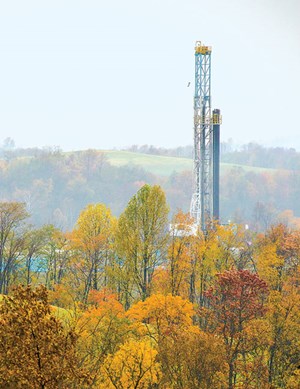Shale gas: Industry revolution or public revolt?
The energy landscape has witnessed a revolution over the last decade. Shale gas exploration and production has played an increased role on the global stage, and the energy market has been transformed. Whereas conventional oil and gas were once dominant, shale has been the center of discussion as an energy source with proven commercial potential, but also of much public controversy.
The story of shale gas drives much debate, as it is viewed quite differently, depending on the community. For some, it is an energy bonanza for commercial growth. For others, it is a source of serious concern regarding its environmental impact. On the one hand, the U.S. industry has experienced a new era of growth, where technology has helped companies to produce cheaper energy and reduce environmental impact. On the other hand, governments in Europe are embroiled in political differences, and face public outrage over how shale gas is extracted, and its effect on the community. A clearer strategy is needed to help all parties resolve their differences.
COMMERCE VERSUS COMMUNITY
The exploitation of a shale gas deposit progresses through three distinct phases—from the discovery stage, to drilling and reservoir evaluation, to final production. Shale comprises more than half of the earth’s sedimentary rock. Shale gas, in particular, is a low-cost, carbon-friendly alternative to traditionally used fuels. Considerable deposits are being discovered across the world. So, for many countries, shale gas is well-positioned to supply a growing proportion of the world’s energy needs.

On the commercial front, the increase in natural gas output is expected to eventually provide further impetus for the North American industry, and provide more benefits to U.S. consumers. Extraction of natural gas from unconventional formations, such as shale, has become more technologically and economically viable, due to continuous developments in horizontal drilling and hydraulic fracturing, Fig. 1. Despite current low prices, the rewards in the mid-to-long term are potentially enormous. Expanded shale activity supports the refining and petrochemical sectors, although it also has reduced operating costs for industries like steel production and manufacturing.
The abundance of low-cost U.S. gas comes at one-third the price of European gas. This imbalance puts European industrial production at a heavy cost disadvantage in relation to the U.S. Given the expansion of U.S. shale gas, U.S. energy self-sufficiency had been predicted by 2020, although the downturn in oil prices may push the timetable back by several years. This scenario, in turn, has meant that countries, such as Qatar, have needed to change export plans away from the U.S., and increase exports to Asia, mainly China and Japan.
Another notable shift in direction is in the Middle East, where owner-operators already have moved downstream to counter the weakened losses in the upstream sector. Saudi Arabia’s SABIC has had intentions to invest in shale and has been in talks with large U.S. operators, as part of an initiative to build a new ethane cracker that will help globalize the firm’s operations.
Europe, on the other hand, is experiencing serious conflicts-of-opinion. For example, Kurt Bock (Fig. 2), chairman of the board of executive directors of BASF, attacked the German government’s support of renewables in a recent interview with the German news magazine Der Spiegel. He noted that chemical companies have to pay far too much for the energy that they use. He believes Europe, and especially the UK, should focus its efforts, when it comes to energy supplies, on shale gas. He continued to state that BASF’s oil and gas subsidiary, Wintershall, “has used techniques similar to hydraulic fracturing to extract tight gas for decades,” and the only reason he believes a fracing revolution isn’t sweeping Europe, is due to “myths” surrounding fracing.

The progress of shale gas exploration and development in Europe has been restricted by tight legislative policies, and numerous environmental and human health campaigners. The increasing power of anti-shale gas lobbying has inhibited progress, due to strong public opinion on the viability, and impact, of fracing. Some countries, like the UK, have faced serious concerns and protests from campaigners over the technique’s possible effects on groundwater contamination.
Efforts to standardize fracing procedures, including disclosure of fracing fluid content and publication of geological effects, continues to evolve on political and environmental levels. Much of the controversy surrounds not just the drilling process, but also the fact that fracing involves pumping sand, chemicals and water at extremely high pressure, deep into the ground, to extract gas trapped in shale rock layers. The potential impact of fracing on the environment is a major issue for many governments and regulatory organizations.
Europe does not have a universal policy regarding production of unconventional gas, and until the European Union (EU) sets a clear standard, it will be difficult to see how European regions will be able to gain the same level of success, as has already been seen in the U.S. The procrastination in Europe over policy decisions, and the setting of regulations, is said by many leading experts to stifle progress and restrict job growth in the industry. In contrast, shale gas has been the catalyst for the U.S. chemical industry’s rejuvenation, and it brings enormous economic advantages to the industry as a whole, including the generation of job opportunities.
TECHNOLOGY REVOLUTION
For many businesses, however, it is the accessibility of shale gas that is a commercial concern. The intense capital outlay places enormous pressure on companies to exploit and process the resource as economically as possible, to see a good return on investment. Conventional horizontal drilling technologies have been used widely in the U.S. to drill shale gas wells and, generally, the rock around the wellbore must be hydraulically fractured before it can produce significant amounts of gas. This expensive process can amount to as much as 25% of the total cost of a well. Yet, hydraulic fracturing and horizontal drilling make the recovery of shale gas economically viable. Inadequate midstream infrastructure, including processing plants, storage fields and LNG terminals, is an area that requires specialized investment. These dynamics apply not just to the U.S., but to any region where shale gas exists.
ROLE OF SOFTWARE
Technology is, therefore, a crucial component for companies wanting to transport and process gas reserves. Software technology helps to facilitate the need for improved cost efficiencies. The adoption of midstream software solutions enables companies to bring new gas and liquids processing facilities to market faster, with a higher return on investment. The software reduces capital costs through steady-state and dynamic process optimization, and it lowers operating costs by integrating simulation models with plant data for operations planning and decision support.
In an operational context, our
aspenONE software optimizes manufacturing and supply chains, subject to economics, feeds, constraints and demands, while providing the agility to react to changing market conditions. Maximizing midstream assets for optimal profitability is vital, certainly when margins are tight in highly competitive markets. Process industry software helps optimize unconventional shale play opportunities by aligning inventory and distribution with market demand.
SHALE TALE CONTINUES
Global shale gas propagation has opened opportunities for many countries to review their energy strategies and chemical feedstocks. The markets are turbulent, due to the growth of U.S. shale exploitation, while governments in Europe are embattled with regulation quandries and environmentalists angered at the potential long-term effects that shale exploitation will, they think, have on the world’s ecosystems. Essentially, the process industry and communities are witnessing different levels of maturity and understanding worldwide.
Putting shale into context is crucial. Shale must be reviewed on a case-by-case and region-by-region basis. What works in the U.S. may not be appropriate for Europe, Asia or other parts of the world. However, with energy demand increasing globally, there is a growing need for industry and governments to establish clear regional policies and parameters in which to work. Compliance and regulation, technology and proven techniques, and communication and public consultation are essential ingredients to resolve conflicting issues and quash the remaining myths around shale gas. Better information—in Europe especially—will allay public fears of shale exploration on the environment and communities. It also will help businesses set commercial expectations, and plan more strategically, without fear of public retribution.
The revolution in technology has provided great wealth for the process industry. The revolt from the public has created much angst and scepticism. No matter which side of the argument you stand on, the “hail to shale” versus “shale to fail” debate will rage on. ![]()
- Shale technology: Bayesian variable pressure decline-curve analysis for shale gas wells (March 2024)
- Prices and governmental policies combine to stymie Canadian upstream growth (February 2024)
- U.S. producing gas wells increase despite low prices (February 2024)
- U.S. drilling: More of the same expected (February 2024)
- U.S. oil and natural gas production hits record highs (February 2024)
- Mixed outlook for activity on the UK Continental Shelf (December 2023)


